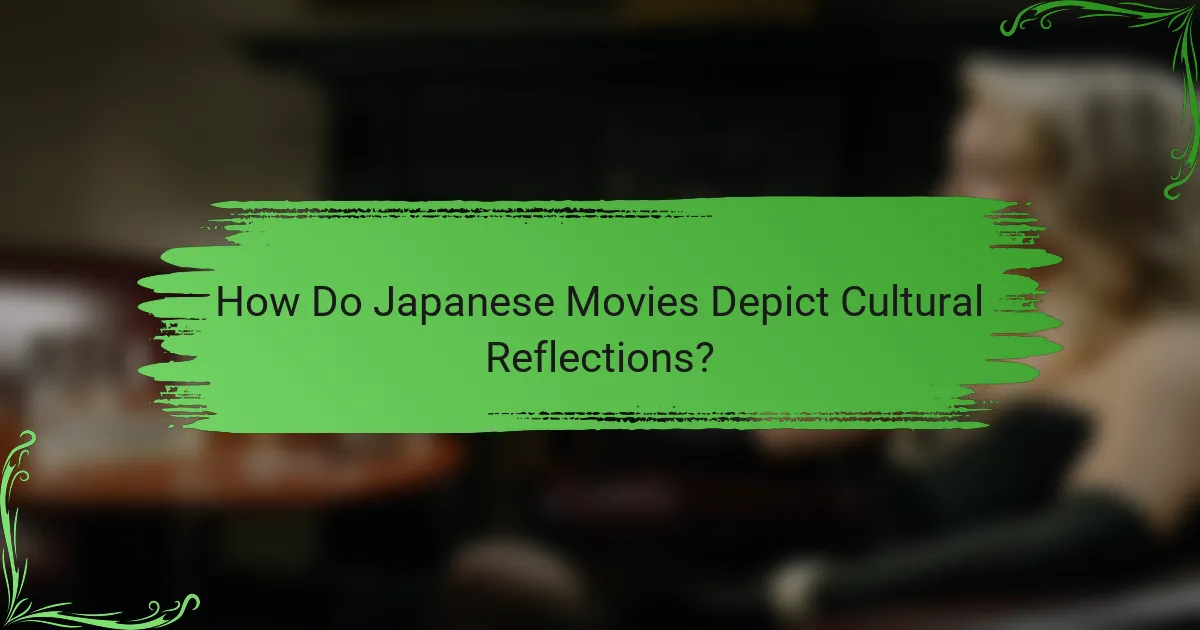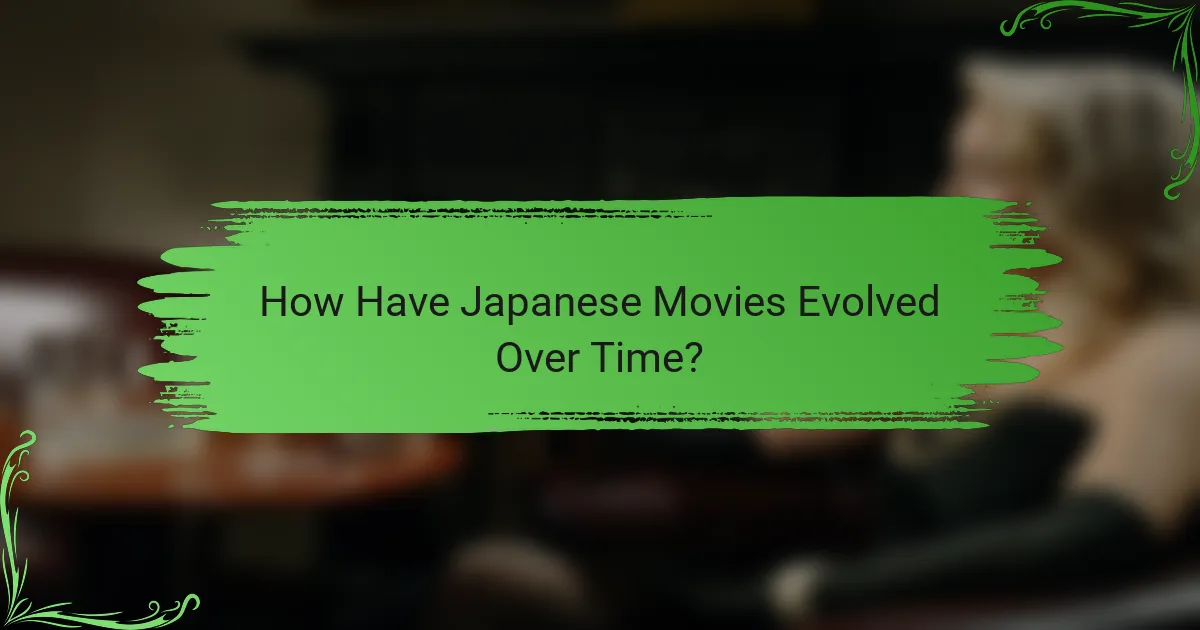Japanese cinema has played a pivotal role in depicting historical events, offering audiences a profound understanding of the nation’s complex past. Through compelling storytelling, these films not only highlight significant moments in history but also delve into the cultural and emotional legacies that continue to influence Japanese society today.

What Are the Most Influential Japanese Movies Reflecting Historical Events?
Several Japanese films have profoundly impacted the portrayal of historical events, offering unique insights into the nation’s past. These movies not only reflect significant moments in history but also explore the cultural and emotional legacies left behind.
Rashomon (1950) – Multiple Perspectives on Truth
Rashomon is a groundbreaking film that delves into the nature of truth and perception through the conflicting testimonies of witnesses to a crime. Set in a forest near Kyoto, it presents a murder and rape from four distinct viewpoints, challenging viewers to question the reliability of memory and perspective. This narrative technique has influenced countless films worldwide, emphasizing the complexity of human experience.
The film’s exploration of subjective truth resonates in various contexts, making it a timeless piece that reflects the moral ambiguities of post-war Japan. Rashomon’s impact on storytelling techniques continues to be felt in modern cinema, highlighting the importance of perspective in understanding historical events.
Ikiru (1952) – Life and Death in Post-War Japan
Ikiru tells the poignant story of a bureaucrat diagnosed with terminal cancer who seeks meaning in his life. Set against the backdrop of post-war Japan, the film examines themes of mortality, legacy, and the struggle to find purpose amidst societal apathy. The protagonist’s journey to create a playground for children symbolizes hope and the desire for positive change in a recovering nation.
This film encourages viewers to reflect on their own lives and the impact they can have on their communities. Ikiru remains a powerful reminder of the human capacity for compassion and the importance of leaving a lasting legacy, particularly in times of crisis.
Grave of the Fireflies (1988) – Impact of War on Innocence
Grave of the Fireflies is a heartbreaking animated film that portrays the devastating effects of World War II on two siblings in Japan. Through their struggle for survival amidst the destruction, the film highlights the loss of innocence and the harsh realities faced by civilians during wartime. The emotional depth and realism of the characters resonate with audiences, making it a poignant reflection on the consequences of conflict.
This film serves as a powerful anti-war statement, emphasizing the human cost of war and the enduring scars it leaves on society. Grave of the Fireflies remains a crucial part of Japanese cinema, reminding viewers of the fragility of life and the importance of empathy in understanding historical tragedies.
Letters from Iwo Jima (2006) – Japanese Soldiers’ Perspective
Letters from Iwo Jima offers a rare glimpse into the lives of Japanese soldiers during the Battle of Iwo Jima in World War II. Directed by Clint Eastwood, the film presents the conflict from the perspective of the Japanese, humanizing the soldiers and showcasing their fears, hopes, and sacrifices. This approach challenges traditional narratives that often focus solely on the American viewpoint.
By exploring the emotional struggles of the soldiers, the film fosters a deeper understanding of the complexities of war and the shared humanity of those on opposing sides. Letters from Iwo Jima contributes to a more nuanced discussion of historical events, encouraging viewers to consider multiple perspectives in their understanding of the past.

How Do Japanese Movies Depict Cultural Reflections?
Japanese movies often serve as a mirror to the nation’s cultural values, societal changes, and historical events. Through storytelling, they explore themes such as identity, family, and societal pressures, providing insight into the evolving Japanese psyche.
Spirited Away (2001) – Modern Japanese Identity
“Spirited Away” illustrates modern Japanese identity through its protagonist, Chihiro, who navigates a spirit world that reflects contemporary societal issues. The film addresses themes of consumerism, environmentalism, and the loss of cultural heritage, resonating with audiences both in Japan and globally.
The film’s rich symbolism and character development highlight the struggle between tradition and modernity, showcasing how individuals adapt to rapidly changing circumstances. Chihiro’s journey represents the resilience and adaptability of the Japanese people in the face of societal transformation.
Tokyo Story (1953) – Family Dynamics and Change
“Tokyo Story” poignantly captures the evolution of family dynamics in post-war Japan. The narrative follows an elderly couple visiting their children in Tokyo, only to find that their offspring are too preoccupied with their own lives to care for them, reflecting a shift in familial responsibilities and values.
This film underscores the tension between traditional family structures and the modern, urban lifestyle that emerged in the mid-20th century. It serves as a reminder of the importance of familial bonds while critiquing the growing individualism in Japanese society.
Battle Royale (2000) – Youth and Society’s Pressures
“Battle Royale” presents a harrowing depiction of youth and societal pressures in Japan. The film’s premise—students forced to fight to the death—serves as an extreme metaphor for the intense competition and expectations faced by young people in contemporary society.
This film critiques the educational system and societal norms that prioritize success over individual well-being. It raises questions about the value placed on conformity and the psychological toll it takes on the youth, making it a powerful commentary on the darker aspects of modern Japanese culture.

What Are the Key Themes in Japanese Historical Cinema?
Japanese historical cinema often explores themes such as conflict, cultural evolution, and personal identity, reflecting the nation’s complex past. These films serve as a medium to examine how historical events shape societal values and individual experiences.
War and Peace – Representation of Conflict
War and peace are central themes in Japanese historical cinema, often depicted through the lens of major conflicts like World War II and the Samurai era. Films such as “The Last Samurai” and “Grave of the Fireflies” illustrate the devastating impacts of war on individuals and families, showcasing both the brutality of conflict and the longing for peace.
These narratives frequently highlight the moral dilemmas faced by characters, emphasizing the human cost of war. Viewers are invited to reflect on the consequences of violence and the enduring hope for reconciliation and harmony in post-war society.
Tradition vs. Modernity – Cultural Tensions
The tension between tradition and modernity is a recurring theme in Japanese historical films, illustrating the struggle to maintain cultural heritage in a rapidly changing world. Movies like “Ikiru” and “Rashomon” explore how traditional values clash with contemporary societal expectations, often leading to personal and communal conflict.
This theme resonates with audiences as it mirrors Japan’s own journey through modernization, prompting discussions about the preservation of cultural identity amidst globalization. Filmmakers use these narratives to question what aspects of tradition should be upheld and how they can coexist with modern life.
Identity and Memory – Personal Narratives
Identity and memory play crucial roles in Japanese historical cinema, often focusing on personal stories that reflect broader societal issues. Films such as “Tokyo Story” and “A Class to Remember” delve into the ways individuals grapple with their past, shaping their identities in the context of historical events.
These narratives often emphasize the importance of memory in understanding one’s place in society, highlighting how personal experiences are intertwined with collective history. By portraying the struggles of characters to reconcile their pasts, these films encourage audiences to reflect on their own identities and the legacies of history.

What Criteria Should You Use to Select Japanese Historical Films?
When selecting Japanese historical films, consider the film’s authenticity, narrative depth, and the director’s vision. Look for films that accurately represent historical events, offer cultural insights, and are crafted by filmmakers known for their storytelling prowess.
Director’s Influence – Renowned Filmmakers
The director plays a crucial role in shaping the narrative and visual style of historical films. Renowned filmmakers like Akira Kurosawa and Masaki Kobayashi have set high standards with their ability to blend historical accuracy with compelling storytelling.
When choosing a film, consider the director’s previous works and their approach to history. For example, Kurosawa’s films often reflect the complexities of human nature against historical backdrops, while Kobayashi’s works frequently critique social issues within historical contexts.
Cultural Significance – Impact on Society
Japanese historical films often serve as a mirror to society, reflecting cultural values and historical consciousness. These films can influence public perception of historical events and contribute to national identity.
For instance, films depicting the samurai era not only entertain but also explore themes of honor, loyalty, and sacrifice, resonating deeply with Japanese audiences. Selecting films that engage with these cultural themes can enhance your understanding of Japan’s historical narrative and its legacy.

How Have Japanese Movies Evolved Over Time?
Japanese movies have undergone significant evolution, reflecting changes in society, technology, and global influences. From the post-war era to contemporary cinema, filmmakers have adapted their narratives and styles to resonate with both local and international audiences.
Post-War Cinema – Shifts in Narrative Style
Post-war Japanese cinema saw a dramatic shift in narrative style, moving from traditional storytelling to more complex and nuanced themes. Filmmakers like Akira Kurosawa and Kenji Mizoguchi explored human emotions and societal issues, often highlighting the struggles of individuals in a changing Japan.
This era introduced the concept of realism in film, with a focus on character development and moral ambiguity. Movies such as “Rashomon” and “Tokyo Story” challenged audiences to reflect on the nature of truth and relationships, setting a new standard for storytelling in Japanese cinema.
Contemporary Trends – Globalization and Influence
In recent years, Japanese cinema has embraced globalization, leading to a fusion of styles and influences from around the world. This trend has resulted in a diverse range of films that appeal to international audiences while maintaining unique cultural elements.
Contemporary filmmakers like Hayao Miyazaki and Hiroshi Kurosawa incorporate global themes while addressing local cultural narratives. The rise of streaming platforms has further facilitated this exchange, allowing Japanese films to reach wider audiences and gain recognition at international film festivals.

What Are the Emerging Trends in Japanese Cinema?
Emerging trends in Japanese cinema reflect a dynamic landscape, characterized by increased international collaborations, a focus on diverse narratives, and technological innovations. These trends not only enhance the storytelling experience but also broaden the reach of Japanese films globally.
Increased International Collaborations
Japanese filmmakers are increasingly partnering with international studios and talents, creating films that appeal to a global audience. These collaborations often result in co-productions that blend cultural elements and storytelling techniques, enriching the cinematic experience.
For example, films like “Shin Godzilla” have seen input from international teams, allowing for a fusion of perspectives that resonate with viewers beyond Japan. This trend is likely to continue as filmmakers seek to tap into larger markets and diverse audiences.
Focus on Diverse Narratives and Voices
There is a growing emphasis on telling stories from varied perspectives, particularly those that highlight underrepresented voices in Japanese society. This shift is evident in films that explore themes of gender, ethnicity, and social issues, providing a more comprehensive view of contemporary Japan.
Directors like Hiroshi Kurosawa and Naomi Kawase are leading this movement, crafting narratives that challenge traditional norms and reflect the complexities of modern life. Audiences are responding positively, seeking films that resonate with their own experiences and broaden their understanding of different cultures.
Technological Innovations in Filmmaking
Advancements in technology are transforming how films are made in Japan, from CGI to virtual reality. These innovations enable filmmakers to create visually stunning works that push the boundaries of storytelling.
For instance, the use of high-definition cameras and sophisticated editing software has become standard, allowing for greater creativity and precision in film production. Additionally, the rise of streaming platforms has changed distribution methods, making it easier for independent filmmakers to reach audiences worldwide.
